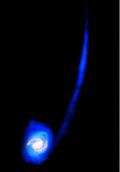News 2007
What is a galaxy ? Stars, gas, some dust and surrounding them an invisible dark matter halo. The discovery a few years ago of a so-called « dark galaxy » devoid of its most famous component - the stars - raised a lot of interest in the public and among astrophysicists puzzled by a specimen which had not been predicted by classical models. A team from the Service d'Astrophysique (SAp) and laboratory AIM (CNRS, CEA-Saclay, Université Paris Diderot has used numerical simulations to show that VirgoHI21, believed to be a massive dark galaxy, was in fact most probably collisional debris from a past encounter between two massive galaxies in the Virgo Cluster. The prototypical dark galaxy is no longer one ! These results will be published in the February 2008 issue of the Astrophysical Journal.
The high resolution images provided by the Cassini spacecraft have uncovered a surprising shape for two small Saturn satellites located inside the rings of the giant planet. An international team, leaded by Sébastien Charnoz and André Brahic from the Service d'Astrophysique (SAp) of CEA/DSM/DAPNIA and laboratoire AIM (CNRS, Université Paris Diderot), have just shown that the Pan and Atlas satellites, two small moons with only a 30 km radius, are circled at their equator by an important padding making them looking like "flying saucers". Thanks to numerical simulations able to reproduce the collisions among particles taking place inside the Saturn rings, the astronomers have now gain new indications that the small bodies have indeed "grown" inside the rings. They constitute a new evidence that the Saturn rings originate from the cataclysmic desintegration of a bigger satellite or comet.
These results are published in Science of 7 décembre 2007.
For details and more information in French : click HERE
The first Astronomical image taken by a new generation of camera called "ArTeMiS-1" were obtained with the APEX telescope in March 2007, at Chajnantor in Chile. This bolometer camera operates in the "submillimetre" domain, between the infrared and the millimetre waves, where the cold objects of the Universe emit most of their energy. The camera is based on the technology developed at the Service d'Astrophysique of CEA/DAPNIA, and LETI/LIR at CEA/Grenoble for the Herschel Space Observatory. This successful astronomical observation is the first step toward regular astronomical observations to study star formation throughout the Universe.



